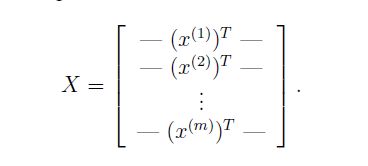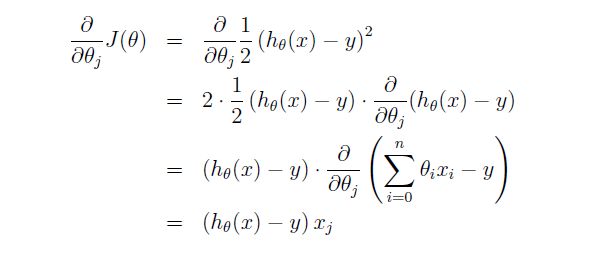监督学习&回归问题(Regression)
分类
- 回归问题:学习的结果是连续的,比如房价等等
- 分类问题:学习的结果是非连续的,分成某几个类
梯度下降
条件:
- 对于输入X有n个特征值。X = { x1,x2,x3,x4,.......,xn x 1 , x 2 , x 3 , x 4 , . . . . . . . , x n }
- 一共有m组输入。 X1,X2,......,Xm X 1 , X 2 , . . . . . . , X m
结果:
假设:
特点:
- 都具有局部最小值
- 最后的结果并不一定是总体的最小值
1.批梯度下降:
思路:
先初始化 θ θ = 0向量,然后通过学习,不断改变 θ θ 使 Jθ J θ 不断减小,致使方程不断在学习点逼近真值。(至于为什么要选择最小二乘法和为什么这个值有极限,稍后给出证明)-
- α α 决定下降速度
注意:
- 该算法每次迭代查看了所有样本,知道 θ θ 收敛
- 收敛的意思是:误差在允许的范围内就没有继续发生变化了
2.增量梯度下降:
正规方程组
1.矩阵导数
2.最小二乘法
令 J(θ) J ( θ ) 偏导为 0 我们可以直接求出 θ θ , 推导过程:




概率论解释
1.问题:
为什么在线性回归中我们要用最小二乘作为误差项,而不用三次方,四次方之类的。
2.解答:
所以:

即: y(i) y ( i ) | x(i);θ x ( i ) ; θ ~ N(θTx(i),σ2) N ( θ T x ( i ) , σ 2 )理解:
我们把输入X,X = { x1,x2,x3,x4,.......,xn x 1 , x 2 , x 3 , x 4 , . . . . . . . , x n }看做一组样本,而 Y Y 是一组样本对应的观测值,而且由前面的推导我们可以知道该事件是符合 y(i) y ( i ) | x(i);θ x ( i ) ; θ ~ N(θTx(i),σ2) N ( θ T x ( i ) , σ 2 ) 。因此利用最大似然法我们可以求出未知参数 θ θ ,即最大化 L(θ) L ( θ ) 。
代码实现:
主要文件:
- test1相当于主要文件
- GradientDecent主要是梯度下降更新 θ θ
- ComputeCost主要用来根据给出的 θ θ 计算出代价 J J
test1函数:
%% part0; 装载数据
data = load('ex1data1.txt');
x = data(:,1);
y = data(:,2);
m = length(y);
%% part1: 初始化,画出离散的点
plot(x,y,'rx','Markersize',10);
ylabel('profit in $10,000s');
xlabel('population in $10,000s');
pause;
%% part2:run gradient descent,view theta
x = [ones(m,1), data(:,1)];
theta = zeros(2,1);
iterations = 1500;
alpha = 0.01;
computeCost(x, y, theta)
theta = gradientDescent(x, y, theta, alpha, iterations);
x2 = 4:25;
y2 = theta(1,1) + theta(2,1) * x2;
plot(x(:,2),y,'rx',x2,y2,'blu','Markersize',10);
ylabel('profit in $10,000s');
xlabel('population in $10,000s');
pause;
%% Part 4: Visualizing J(theta_0, theta_1)
%给出相应的theta0,theta1的连续值100个,组成100*100的theta矩阵,根据每个theta组合算出cost J形成一个三维图形
%theta0, theta1, J。方便查看J的下降方向
fprintf('Visualizing J(theta_0, theta_1) ...\n')
% Grid over which we will calculate J
theta0_vals = linspace(-10, 10, 100);
theta1_vals = linspace(-1, 4, 100);
% initialize J_vals to a matrix of 0's
J_vals = zeros(length(theta0_vals), length(theta1_vals));
% Fill out J_vals
for i = 1:length(theta0_vals)
for j = 1:length(theta1_vals)
t = [theta0_vals(i); theta1_vals(j)];
J_vals(i,j) = computeCost(x, y, t);
end
end
% Because of the way meshgrids work in the surf command, we need to
% transpose J_vals before calling surf, or else the axes will be flipped
J_vals = J_vals';
% Surface plot
figure;
surf(theta0_vals, theta1_vals, J_vals)
xlabel('\theta_0'); ylabel('\theta_1');
% Contour plot
figure;
% Plot J_vals as 15 contours spaced logarithmically between 0.01 and 100
contour(theta0_vals, theta1_vals, J_vals, logspace(-2, 3, 20))
xlabel('\theta_0'); ylabel('\theta_1');
hold on;
plot(theta(1), theta(2), 'rx', 'MarkerSize', 10, 'LineWidth', 2);
GradientDecent函数:
function [theta,J_history] = gradientDescent(x, y, theta, alpha, num_iters)
%GRADIENTDESCENT Performs gradient descent to learn theta
% theta = GRADIENTDESENT(X, y, theta, alpha, num_iters) updates theta by
% taking num_iters gradient steps with learning rate alpha
% Initialize some useful values
m = length(y); % number of training examples
J_history = zeros(num_iters, 1);
thetas = zeros(num_iters,2);
for iter = 1:num_iters
% ====================== YOUR CODE HERE ======================
% Instructions: Perform a single gradient step on the parameter vector
% theta.
%
% Hint: While debugging, it can be useful to print out the values
% of the cost function (computeCost) and gradient here.
%
for j = 1:2
dec = 0;
for i = 1:m
dec = dec + (x(i,:)*theta - y(i,1)) * x(i,j);
end
theta(j,1) = theta(j,1) - alpha*dec/m;
end
% ============================================================
% Save the cost J in every iteration
J_history(iter) = computeCost(x, y, theta);
end
end
ComputeCost 函数:
function J = computeCost(x, y, theta)
%COMPUTECOST Compute cost for linear regression
% J = COMPUTECOST(X, y, theta) computes the cost of using theta as the
% parameter for linear regression to fit the data points in X and y
% Initialize some useful values
m = length(y); % number of training examples
% You need to return the following variables correctly
J = 0;
% ====================== YOUR CODE HERE ======================
% Instructions: Compute the cost of a particular choice of theta
% You should set J to the cost.
for i=1 : m
J = J + (y(i,:)- x(i,:)*theta)^2;
end
J = J /(2*m);
% =========================================================================
end
代码
百度云下载
其它平台只是信息转发(留言可能看不到),欢迎同学们到个人blog交流:https://faiculty.com/
















